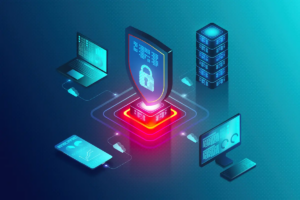Endpoint detection response (EDR) is a security solution that utilizes real-time monitoring and endpoint data collection to identify threats before they penetrate a company network, including threats that bypass anti-malware protection.
Effective EDR tools feature several essential capabilities that enable organizations to detect, investigate and respond more rapidly to cyber attacks. These capabilities may include:
Real-time Threat Detection
Cyber threats pose an ever-increasing risk to businesses of all sizes. From lost productivity and brand reputation damage to financial losses, their effects can be catastrophic – thus, security teams must be ready for incidents when they arise.
Real-time threat detection (RTD) is the ultimate tool for safeguarding against such intruders, acting like an invisible net to detect intruders that have bypassed your current security defences. RTD includes tools like network traffic analysis technology, endpoint threat detection, which identifies suspicious events on user machines and security intelligence, which provides insight into threats in the threat landscape.
Traditional detection methods like EDR, XDR and MDR provide after-the-fact analysis and reporting; however, CISOs and IT leaders wish to prevent attacks as they happen.
Automated Incident Response
Security teams must respond swiftly and appropriately when threats emerge, yet this process can be complex, time-consuming and resource intensive. Security teams may face an overwhelming number of alerts that don’t directly relate to any specific threat; plus, it can be hard to quickly pinpoint the root cause of an issue, all of which could lead to SOC team burnout which directly affects employee productivity and retention.
An effective incident response tool can reduce alerting noise and help analysts focus on what matters most – less time triaging alerts and more time dedicated to analyzing and resolving critical incidents that threaten your organization’s infrastructure.
Automated incident response integrates threat intelligence to help quickly recognize and respond to the most severe threats faster, assisting businesses to avoid costly penalties for data breaches or downtime caused by cyber-attacks while improving SOC team efforts.
When selecting an AIR vendor, look for solutions to meet immediate and long-term security needs. Determine how automation could benefit your organization’s unique situation – are there recurring security incidents requiring a structured response playbook that might need automated responses? If this is the case for you, an automated response playbook solution may be worth exploring further.
Advanced Threat Detection
An effective EDR solution leverages machine learning and big data to quickly detect threats in real-time, which is critical because modern attacks often use stealthy techniques that evade traditional antivirus software or detection techniques. Quickly identifying root causes and initiating appropriate responses can significantly decrease cyber attack duration time and thus minimize its potential impact on organizations.
EDR solutions provide:
Three core functions.
Recording endpoint-system-level behaviours.
Detecting suspicious activities and alerting security teams of them.
To accomplish these objectives, the solution ingests and analyzes massive amounts of telemetry generated by endpoints or networks and looks for patterns which may indicate threats are present.
Machine learning technology then analyses this information, creating a baseline of normal behaviour that identifies any anomalies that might indicate security incidents. Once flagged, relevant personnel are informed and automated response actions such as isolating an endpoint and blocking malicious activity are initiated as appropriate.
Best EDR solutions employ advanced threat detection methods to identify unknown and emerging threats, including ransomware, zero-day malware and fileless attacks. This is achieved using different techniques, including sandboxing. BluVector’s next-generation NDR utilizes these technologies effectively and efficiently to detect threats in real-time and reduce mean time to respond (MTTR). Learn about our machine learning technology that improves threat detection while simultaneously investigating and mitigating any incidents which might impact your business quickly and automatically.
Continuous Visibility
Continuous Visibility refers to your ability to monitor every event happening within and moving through your network, from data collection, aggregation and distribution processes all the way through. It requires effective yet scalable data collection, storage and distribution mechanisms.
Continuous Visibility means detecting threats in real-time, providing security teams with context that enables them to prioritize alerts and initiate responses quickly. Without continuous Visibility, security incidents may go undetected for long periods resulting in lasting damage; EDR solutions must incorporate correlated telemetry that maps environment context with endpoint processes and activities for continuous Visibility.
Unified file visibility can assist in detecting insider threats and data leakage by highlighting suspicious or abnormal activity, such as attempted access attempts or unusual data transfers that indicate potential breaches. Furthermore, it assists with data loss prevention (DLP) policy enforcement and file movement tracking to detect compliance violations.
Open EDR is designed with one thing in mind – making endpoint detection and response accessible to everyone, not just privileged individuals. As such, its makers believe this foundational cybersecurity stack should become a right, which is why they make it free for deployment, use and management. Start protecting your organization with Open EDR today; deployment only takes minutes while instantly improving protection! Explore what else this innovative, open-source solution can do for you – download your copy today.
